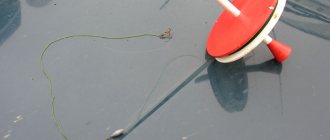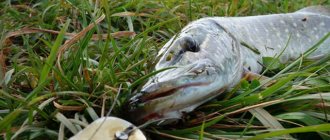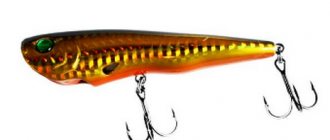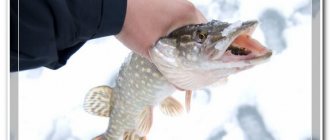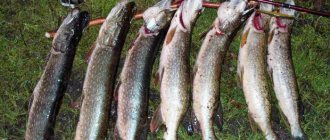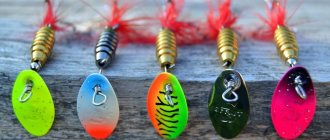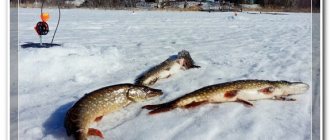Fans of effective and mobile winter fishing have more than one balancer option in their arsenal. Fishing for pike on a balance beam in winter, more often than others, allows you to get away from zero, when it would seem there are no more chances.
Several color options for this small artificial fish can correct the situation even in the dead of winter (in January, early February), when only winter gizzards can compete. A precise game, reminiscent of the movements of a wounded or sick fish, provokes an inactive predator to bite.
How does the tackle for fishing with a balance beam work?
Let's consider the main elements of equipment. The equipment of a winter fishing rod for pike under a balancer includes the following elements:
Fishing rod
Its basis is the fishing rod, on which all other elements of the tackle will be placed in one way or another. It must be durable and at the same time capable of absorbing the jerks of this strong fish. The recommended length of the fishing rod (excluding the handle) should be between 30-60 cm. This will allow you to create an effective action of the bait, as well as absorb the jerks of the pike during biting and fishing.
Coil
Reels are most often used inertialess, less often multiplier ones with a friction brake, of medium size. When hit by a large pike, the fishing line may not be able to withstand it, so a properly adjusted clutch is what will save you from an annoying break or slip.
fishing line
The shock-absorbing properties and resistance to freezing of the fishing line give it undeniable advantages over braided line. It will smooth out the jerks of the fish during the fight against the toothy predator; you just need to take the necessary precautions, avoiding cutting it on the edges of the hole. However, this can be avoided by using fluorocarbon, which is more resistant to abrasion in the cold. The optimal diameter of the fishing line is 0.25 mm
Leash
Using a leash when catching this toothy predator is mandatory. Her sharp teeth have deprived more than one fisherman of a well-deserved trophy. Many of them prefer to make them themselves from guitar strings (size No. 1-2), without skimping on high-quality swivels and carabiners. If we are talking about buying ready-made ones, then you should pay attention to trusted manufacturers. A damaged leash must be promptly replaced with a new one, otherwise the game of the balancer may be hopelessly ruined.
Fishing for pike in March from ice
In early spring, in many areas, fishing continues using winter methods: baits, girders, balancers, spoons.
An article on making vents with your own hands is here .
How to fish correctly with girders
Appearance of the girder
The following types of girders are used in pike fishing:
- Platform;
- On a pole;
- On a tripod.
In March, pike swim to shallow water, so the girders are installed diagonally relative to the shore. To check the depth, the vent is equipped with a sinker that sinks to the bottom.
Equipment:
- Line winding : 17-25 meters.
- Line thickness : 0.3-0.42 mm.
- Hooks - tees 5-8 sizes of domestic numbering.
Installation of live bait gear is optimal at a depth of 40 cm to 1 meter deep. Sprat shows itself best as live bait, but you can use ruff and other small things.
The number of installed girders in winter is from 2 to 5. It is not necessary to install more girders, because bites are quite frequent even without additional girders.
How to attach live bait.
Options for fixing live bait.
Under the gills. Gills + back

3 ways to fix live bait on hooks. The third method is optimal in terms of reliability and invisibility.
To the balancers
Often, pike are caught on balance beams, placing several girders. While the bite is expected on the girders, the holes are fished using balance beams.
The hole is drilled in March, usually 4-5 meters from the shore. The length of the working line is 40-60 cm . Accordingly, the game is played at the same depth.
The rod is taken short, with a sensitive end. Line 0.28-0.40 mm , often 0.36 is the optimal average.
Balancer game. Nods (suspenders) once every 2-3 seconds. If there are no bites, you shouldn’t fish one hole for more than 15-20 minutes, feel free to drill a second one, at least 6 meters from the first.
Fishing with balance beams for beginners:
Winter spinner
In early spring, winter spinners continue to be used - metallic in color, monotonous with a yellowish tint. Holes are drilled 3-5 meters from the shore, 1-2 meters from vegetation.
Preference is given to oscillating spoons of neutral gray-metallic colors. Catchers also use a spoon with a fly.
Line 0.32 mm. The dimensions of the spinners are 3-6 cm. The leader material is fluorocarbon, 0.4 mm.
They jam with not a strong but heavy blow
The best lures for pike – 2021 rating.
Installation of gear
After the angler has chosen and purchased a high-quality fishing line, swivels, fishing rod and other elements of gear, it is time for installation. It happens in the following order:
- A fishing line is tied to the reel and wound in an amount of 20-25 meters. This will be enough, taking into account the depths of the home pond and the likelihood of cutting off the fishing line after it receives damage from the edges of the hole.
- The most powerful whip is installed (if it is possible to install replaceable whips).
- A nod is put on the whip.
- A fishing line is threaded through the hole on the whip and nod.
- A fastener is attached to the threaded fishing line.
- A clasp attached to the fishing line is attached to the balancer.
Well, now the winter fishing rod is assembled, you can start fishing.
Equipping a fishing rod for a balancer
Pike is a serious predator that requires reliable and strong equipment. The optimal tackle for winter fishing with a balancer is a rod 60-70 cm long. It is easier to hook with a rod of this length. And it’s best to have three different rods with different test for baits.
For example, I use a fishing rod made from a composite that provides high strength with good moderate flexibility.
The length of the rod is selected empirically; it is important that it is convenient to play with the balancer. Many fish with short rods, changing only the rods or nods for the tackle.
The whip should be strong and moderately tough. Manufacturers offer various options.
Medium stiffness models ensure compatibility with the most popular balancers. However, if fishing with a balance beam is supposed to be in places abounding in underwater vegetation or snags, it is worth having more sensitive gear with you. This will help distinguish a hook from a pike bite.
And most often, we fish precisely in snags, these are the favorite hunting grounds for pike.
Pike do not always attack the bait with a blow, and this is more typical for fishing on the first ice, during the thaw period, or simply during short periods of fishing.
The handle of a fishing rod should, first of all, be comfortable, fit well in the palm of your hand and made of high-quality material. The best option is a balsa wood handle.
To catch pike, you can place two types of reels on the balancer:
- The first option is a simple reel that operates in two positions: free line recoil and a dead stop. In this case, use a thicker fishing line to avoid the tackle breaking.
- The second option is a “meat grinder”, a small inertia-free reel with an adjustable friction brake. When a good specimen bites, the clutch will release the line itself. You can use thin fishing line 0.2-025 mm.
Recommended reading: What kind of bait does carp like?
I consider a leash 10-15 centimeters long to be an essential element when fishing for pike. You can make it yourself from a guitar string or any steel wire. But it is best to buy braided steel or titanium leaders at a fishing tackle store. Since pike are capable of very aggressive actions when fishing, steel leashes are more suitable than ever.
As for the nod, after several experiments I gave up installing them completely. A correctly selected fishing rod perfectly transmits the bite signal, which is clearly felt in the palm of your hand.
What baits should you use?
Pike is not as picky about bait as perch and responds well to even the most inexpensive models of balancers. The whole point lies not so much in the color, but in the targeted presentation of the bait - as soon as the balancer appears right in front of the predator’s mouth, a reaction will follow on its part. The main thing for the fisherman is to find the desired fishing object.
The most common balancers have sizes from 5 to 10 cm. It is better to immediately replace standard tees and single hooks with better ones. Despite the low price of the bait, you cannot save on hooks - negative emotions will cost more. To make sure that new hooks do not spoil the bait’s performance, you need to test it at home, for example, in the bathroom. Now let's move on to a review of the best balancers.
About
Tackle for pike fishing with balancers
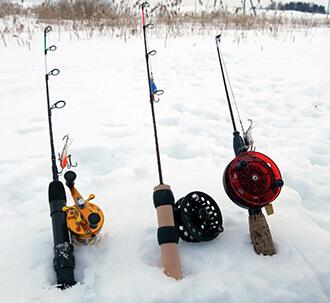
The pike is not a perch, timidly fiddling with the bait and only occasionally “grabbing” it, so no hooking is needed. The silvery predator has practically no worthy rivals in reservoirs and pecks at an imitation live fish without hesitation, grabbing it with its sharp teeth. This can be not only a small tentacle, but also a real trophy, the dream of every angler. And the gear used for fishing on balance beams must correspond to the tasks being solved.
Gawky fishermen have more than once encountered the fact that after biting a trophy pike, the line broke, bitten by the sharp teeth of the predator. And in addition to the loss of fish, this is fraught with the loss of expensive bait, which will be useful on other fishing trips.
Therefore, pike balancers (unlike perch and zander) are tied not to a base, but to a leash that can withstand the teeth of a trophy pike.

The metal leash is a classic of the genre, and when fishing in warm water it does not confuse or alarm the pike. But in winter, in cold and clear water, the predator is more careful and a metal leash can scare it away.
A way out of the situation was found after the advent of fluorocarbon - an abrasion-resistant material, and also transparent. A fluorocarbon leash is somewhat inferior in strength to a metal leash, but this margin is enough to withstand pike teeth.
Another serious drawback of a metal leash is that its rigidity affects the control of the bait, and therefore its “game.” If an artificial fish looks unnatural and behaves unnaturally in the water, this will alert the predator and it will refuse to bite.
Expert opinion
Alexander Popov
Expert fisherman
To ensure a natural “game,” there must be clear contact between the tackle and the bait, and this cannot be achieved with a metal leash. Distorted play of the balancer due to the fault of the leash leads to disastrous fishing results, so when fishing for pike in winter, use fluorocarbon leashes and the performance increases.
The difference between pike winter gear is that when biting, the angler must make an accentuated hook in order to pierce the hard lip of the fish with the hook. It is impossible to make such a hook with a soft nod.
On the other hand, the whip also participates in catching a predator hooked and absorbs its jerks. A fiberglass nod up to half a meter long is the best option for catching winter pike. A hard nod will not allow you to see the delicate bites of the fish, but most often the pike suddenly grabs the bait and its bite is difficult not to notice even with a hard tip of the fishing rod.
The length of the fishing rod depends on the anthropometric data of the fisherman, because it should be convenient for him to make retrieves and quickly hook the fish. There are no restrictions or strict recommendations on the length of the fishing rod, the main thing is that it can withstand a trophy pike, and it is convenient to control the bait and make catchy retrieves.
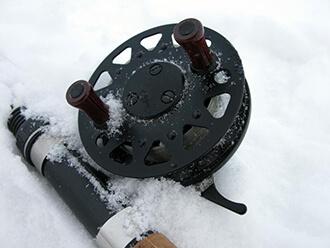
An open-type reel will allow you to quickly lower the balancer to a given depth, and the brake will help you smoothly stop the line when fishing for a trophy predator.
Pike is not a perch or a pike perch, for catching which it is enough to have a supply of fishing line of 5–10 meters. A trophy specimen weighing 4–5 kg or more stubbornly resists, and in order not to break the base, you have to pull out the fishing line, tiring the fish.
Each angler decides for himself what to choose as the main fishing line. If you can put an expensive fluorocarbon fishing line on the base, then all problems are solved. Otherwise, the choice is between braid and monofilament, and the latter option is still preferable.
The braid is stronger and you can take a thinner base of 0.1 mm in diameter. The low stretch of braided fishing line helps when performing sharp strikes with high amplitude, guaranteeing the hooking of a predator with hooks or a tee.
But the disadvantages of braided line offset its advantages and it is not suitable for winter fishing. Braid cannot be called transparent or inconspicuous, and when it gets wet in cold water, it loses its best properties. Even a frost of 8–10º is enough to freeze the braid, and at the same time it loses its strength.
Therefore, anglers choose monofilament fishing lines for the base , and their stretchability (which is considered a disadvantage when hooking) turns out to be an advantage when fishing for trophy pike.
The diameter of the monofilament line for the base is 0.25-0.28 mm, although there are anglers who prefer to play it safe, they take monofilament with a diameter of 0.35 and even 0.4 mm. When fishing with a fluorocarbon leader, the camouflage of the base fades into the background, and when fishing with a thick line, the angler feels more confident and is not afraid of losing the trophy.
Using a thick fishing line has another advantage - it slows down the “game” of the balancer, and with a weak bite this gives an advantage. Like pike perch, pike more often take the bait during a pause in the “game” and with a thick fishing line it is easier to make such pauses.
But a thick base also has disadvantages:
- it sails more strongly when diving;
- the balancer moves more to the side when fishing;
- hooking worsens.
These shortcomings are not so critical as to cause the refusal of monofilament fishing line, therefore, when tying equipment for pike, experienced fishermen choose monofilament as the basis.
When assembling tackle for catching pike on a balance beam, you need to remember that it should be:
- reliable;
- universal;
- compact;
- functional.
Thanks to the use of a leash with a clasp, the process of changing the balancer is simplified, which is very important for the angler in cold weather. But it happens that due to lack of bite, you have to change the balancers in order to stir up the fish and still provoke it to bite.
But even the most correctly assembled tackle for fishing with balance beams does not guarantee an active pike bite and a good catch, because everyone recognizes that in the first place is the angler’s ability to “play” the bait in such a way as to lure the predator.
Tactics for catching pike on a balance beam
We will consider the tactics of finding fish and how to fish correctly using balance beams in stages, depending on the season, fishing location and the condition of the bottom of the reservoir. It is used in cases where the use of other equipment is difficult due to limited wiring - fishing through holes drilled in the ice, or there is a high risk of a “deaf” hook of the spinner. In addition, the vertical movement of the bait does not provoke an attack from the predator. Only a balancer moving simultaneously in two planes, horizontal and vertical, allows one to imitate the movement of a wounded victim in conditions of limited fishing and catch fish.
Fishing for pike on a balance beam in winter on the first ice
The period when water bodies are covered with ice, but severe frosts have not yet set in, is characterized by residual activity of pike. When choosing bait, the main attention is paid to size. The optimal size for winter fishing is 50-70 mm. In winter, pike actively bite when trolling vertically, and the balancer is used in cases where there is a risk of snagging an expensive spoon.
In the wilderness
The period of least activity for pike occurs in mid-winter. The fish are inactive and react sluggishly to bait. She prefers to watch the game of the balancer without approaching it within attacking distance. In this case, ice fishing consists of fishing through a large number of holes, from 20 to 30, which are drilled according to various patterns at a distance of 5-7 meters from each other. Using an echo sounder allows you to determine the nature of the bottom. To attract the attention of a predator, it is necessary to frequently change baits, varying them in size and color. The game with the balancer is not aggressive, it matches the inhibited fish. The chance of a bite increases when changing a large number of holes.
Fishing for pike on a balance beam in winter on the last ice
Spongy, loose ice is a harbinger of rapid melting, which means pike are preparing for spawning (late February, early March). An active zhor is characterized by active attacks on any bait. During this period, the balancers must be large (at least 70 mm), equipped with feathers and planes that change the direction of movement when moving. The game is active, sweeping, with a lot of sharp twitches in the vertical direction.
On the river
Used only in cases where the use of other baits carries a risk of snagging. However, large (32 grams or more), heavy and slow-moving balancers do not allow the current to show the full action of the bait under the oncoming jets of water.
On small rivers
Small rivers and the upper reaches of large ones are a favorite spawning place for pike. They are characterized by an abundance of benthic vegetation and snagged banks. It is inconvenient to cast in these conditions. Pike is caught on a balance beam along the edge of the vegetation or in places with an abundance of snags or overhanging branches of coastal bushes.
On the lake
Particular attention is paid to playing with tackle. In lakes, pike initially prefer shallow, 2-3 meter places on the border of reed thickets. In the middle of winter, it goes into deep holes and falls into suspended animation; closer to winter, it again moves to shallow water, preparing for spawning. It is necessary to experiment when choosing a catchable bait.
About
Techniques for catching pike in winter using lures
The fishing technique is simple - we drill holes, take out the tackle and lower the spoon into the water. Since fishing is done with a spinner and not with live bait, it can be lowered to the maximum depth. By gradually moving the spoon to the hole, you will be able to remember the depth of the pike’s strike and not lower the spoon below it, as this will not give any advantages.
Watch a video on the technique of catching and playing the spoon:
The pike confidently takes the lure from one of the sides, so it’s difficult to miss a bite. The main thing is to hook it in time, since in winter the pike may feel that it has been deceived and spit out the spoon. If a hook occurs immediately after the strike, the fish will not go anywhere. By following the above equipment instructions, you can fish for pike up to five kilograms without thinking about moving it, knocking its strength out, etc.
Spinner game
The game of spinners in winter is different from summer. In winter, the spinner must be brought in 2-3 turns of the reel, and then lowered by about half. So all the way to the top. In principle, it is better to play with all spinners in winter this way, because according to the design features of many of them, it is stipulated that during the descent the spinner should deviate slightly to the side from the ascent trajectory.
What colors of balance bars does pike like?
There is no clear answer to the question of what colors pike like. The catchability will depend on the fishing conditions:
- during daylight hours and in sunny weather - gear of discreet color, which does not glare and does not frighten the fish;
- in cloudy weather - light colors, clearly visible in the water;
- winter balancers for ice fishing are bright, luminous, coated with metal.
The main attention is paid to the natural coloring, imitating fish - dark top, light bottom and wiring technique. “Classic” is considered to be white with a red head, imitation of a perch.
Fishing for pike in March using a spinning rod
In open water, pike fishing begins with spinning rods using wobblers, spinners, and jig baits. First of all, you should choose the right spinning rod for pike.
Let's look at all types of open water fishing.
Pike on wobblers
Equipment and parameters:
- When fishing for pike with wobblers, use a line of 0.12-0.30 mm. For catching small pike, use a fishing line of 0.1-0.14, medium 0.16-0.18, large - 0.22-0.3 mm.
- Lead material (fluorocarbon, string) from 0.28 mm with breaking load up to 12 kg.
- Spinning with dough 10-50 grams. For small individuals, a spinning rod with a dough weight of up to 17 grams is enough. For medium ones from 19 g and so on.
The best wobblers for pike. Wobblers of the following classes are considered catchable for pike (in descending order):
- Minnow;
- Rattlin;
- Popper;
- Fat;
- Crank.
ZipBaits Orbit SP-SR in #070.
Classic wobbler for pike. What color should a wobbler for pike be? The best wobbler for pike and perch is one with a black back, a yellow-red lower part of the belly and a green color between them. Such models are found among wobblers from the following companies: Jackall, ZipBaits, Lucky Craft, Owner, Rapala (x-rap), MegaBass, Deps, Lucky John, etc.
In terms of buoyancy, take with minimal or medium depth. It is stupid to take sinking baits in the spring - the pike itself comes to the surface.
They are caught by twitching from a boat and from the shore. The best wiring for pike is jerking . It makes sense to make windings from different sides. The movements of the rod are also important; they should pull the wobbler along with them, imitating the movements of an ordinary fish.
Video on fishing for pike in winter in open water.
For summer spinners
The rod is taken with a medium-fast action with a weight of 16 to 30 grams. A spinning reel with a front clutch is preferable. The remaining parameters are for amateurs.
Fluor leashes 0.3 mm on average. The length of the leash is 15-25 centimeters. To attach to the main line, it is better to use a swivel or quick release (not when fishing for large pike).
The wiring with spinners and spinners is always uniform . Slow, uniform winding without jerks or pauses. An article on catching pike with spoons.
Pike loves oscillating spoons, here are some of them:
- Mepps Syclops No. 2 – lightweight oscillating (oscillator). Thin metal, good wiring in the upper layers. Color – silver-red.
- Atom Spinnex . For deeper postings.
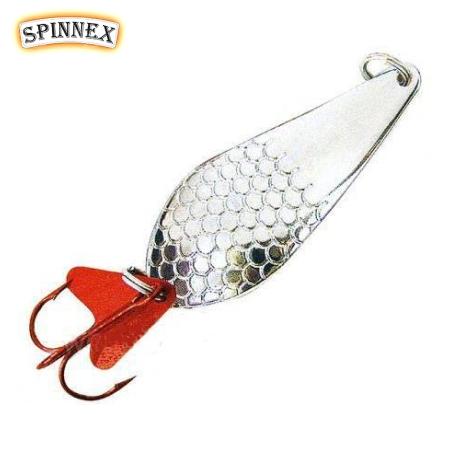
Atom Spinnex
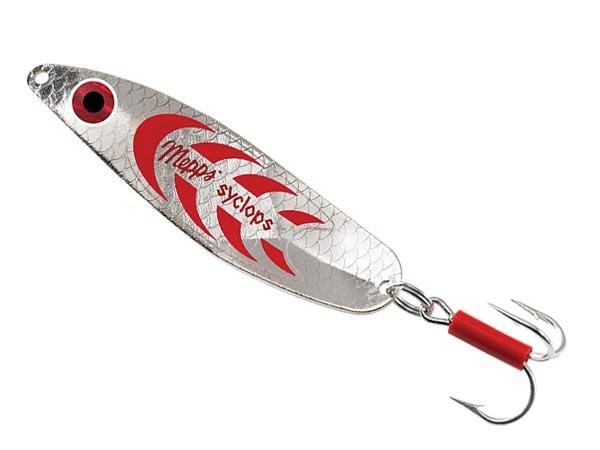
Mepps Syclops – pike classic

On rivers, non-hooking gears are used :
- Kuusamo Professor . It performs well on rivers with a current, where there is a lot of grass.
- Non-snacking Usami Kuusamo Taimen Super . Wiring of medium depth on rivers.
For long casts use heavy spoons:
- Acme Castmaster . Despite its weight, when retrieved, it quickly enters the upper layers of water.
- Luhr Jensen Krocodile , 18 g, 68 mm, Chrome / Fire Stripe. Wiring in medium water columns.
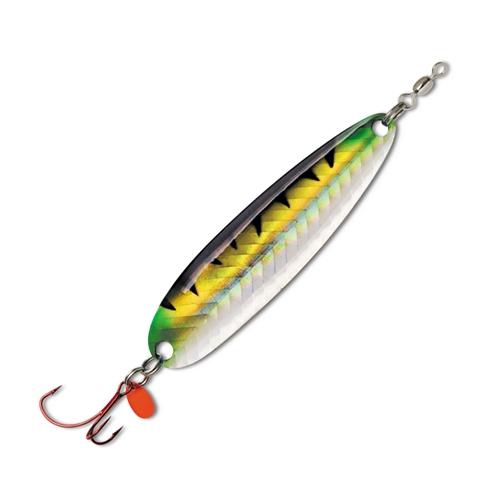
Luhr Jensen Krocodile
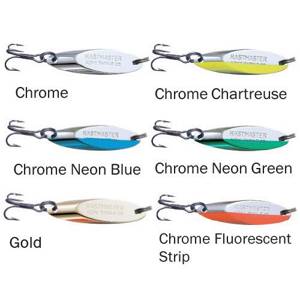
Acme Castmaster – Chrome and Chrome Fluorescent Strip – catchy models for pike

Blue Fox Catchable spinners :
- Mepps Aglia Long . Perhaps the best spinner for pike.
- Vibrax Blue Fox Hot Pepper – heavy, long casting, persistent.
- Mepps with Comet Petal.
- Spinnerbaits with white and green tails and petals.
At shallow depths, light spinners with a wide blade are used. When fishing near vegetation, use hookless baits and spinnerbaits.
Our rating of the top 10 best lures for pike.
Vibrotail fishing
Stepped wiring: a) With loaded vibrating tails along the bottom, b) in the middle and upper layers of water
Vibrating tails are the most effective silicone bait for catching pike in the spring. Twisters are used less frequently.
For fishing on the river, large vibrotails from 5 cm are used. For standing reservoirs up to 4 cm .
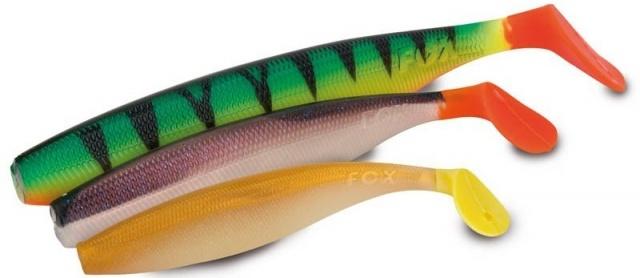
The advantage of vibrating tails is that they can be loaded to animate the game in the water column. Preference is given to vibrotails of dull acidic colors. The manufacturer does not matter, because it is a consumable item.
With loaded vibrotails, a jerk retrieve - the bait goes to the bottom, then pulls up, then goes to the bottom again. Most of the animation of the bait is performed by the rod; reeling (weak) is done while the rod is moving up
When playing with vibrating tails in the middle and upper layers of water, the rod is always kept above the horizon, forming an angle of approximately 45 degrees.
Balancer "Yaroslavl Rocket"
A rare and quite catchy handmade balancer, designed and produced since 1985 by Yaroslavl master Vladimir Paramonov.
All-metal model: top – dark copper, bottom – light brass. Equipped with interchangeable wings, allowing you to change the game when wiring.
Length 50 mm, has two single hooks No. 3 “Mustad” in the head and tail parts and a tee “Cannelle” No. 4 in the abdominal part of the bait. Weight 20.5 grams.
If you decide to buy this model, then keep in mind that the price of the “Yaroslavl Rocket” starts from 1,000 rubles.
The best pike balancers
The variety of artificial fish sometimes confuses novice fishermen, especially since some of them cost a lot and you don’t want to make the mistake of purchasing an expensive but of little use bait. Therefore, a very common question is related to the most catchy baits.
The conditional rating of the best pike balancers is based on reviews from existing fishermen, as well as sales indicators from retail chains. Naturally, the rating is conditional, but it helps to understand and make a profitable purchase.
Nils Master Nisa 50
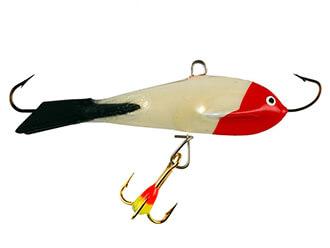
The weight of the bait is 12 grams, length is 5 centimeters. To hold the Nils Master Nisa in a horizontal position when guiding, it is equipped with side stabilizer fins. Thanks to stabilizers, the attractiveness of the “game” of the balancer also increases, which is important when catching predatory fish.
A wide range of colors increases the attractiveness of the lures in this series, and the angler varies them depending on external conditions and the intensity of the bite. There are even luminous Nils Master Nisa, used when fishing in muddy water.
Advantages of a balancer:
- attractive and stable “game”;
- high quality workmanship;
- sharp and durable hooks that reliably catch trophies;
- durability.
Nils Master Nisa is a bait with which the angler feels confident on any type of reservoir, both with current and still water.
Kuusamo Tasapaino 50
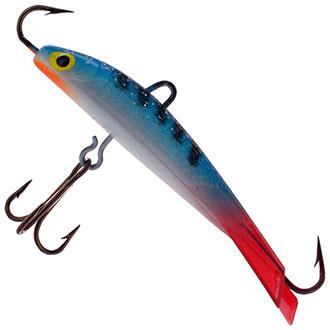
Weight – 7 grams, length 5 centimeters. The tail fin is made of plastic and painted red, attractive to pike that actively hunt in the upper layers of water. With the help of Kuusamo Tasapaino 50 they fish difficult, hard-to-reach areas where other baits do not show results. The narrow body helps to avoid snags, and the realistic coloring does not alarm the predator, but forces it to attack the artificial fish.
Advantages of the Kuusamo Tasapaino 50 balancer:
- streamlined body that helps with complex wiring;
- color resembling a real fish with a silver back and dark belly;
- durable hooks that can be easily pulled out of grass and even the trunks of flooded trees;
- red plastic fin that attracts fish and provides an attractive "game"
Kuusamo Tasapaino 50 is sure to be found in the top of the best lures for pike, and its catchability against this predator is beyond doubt.
Rapala Jigging Rap – w07
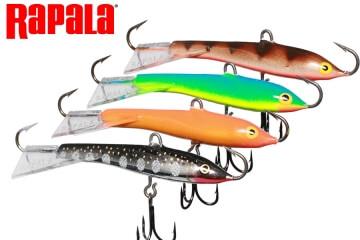
This is evidenced not only by statements from the manufacturer, but also by the size of the bait, the length of which is 7 centimeters. A weight of 18 grams is enough to quickly deliver the balancer to depth, and it is used to fish the bottom areas of rivers and lakes. When fishing near a hole or undercut, Rapala Jigging Rap - w07 is indispensable, as well as in the middle layers of water, especially during thaw periods.
Some anglers feel that the tail fin is not large enough to make a wide retrieve. But this is rather an advantage, because the sweeping “game” of the bait will not always interest the fish standing nearby. In the bottom layer there is often dense vegetation, and hooks with this balancer are rare, and strong hooks help save the bait by pulling it out of the grass.
Advantages of Rapala Jigging Rap – w07:
- high quality coating, ensuring the durability and attractiveness of the bait;
- original "game";
- wide choice of colors;
- durable, streamlined body that provides a natural “game” reminiscent of
- movements of the injured fry;
- Possibility of use both in the middle layers of water and near the bottom.
The Rapala company is famous for its products, in particular, lures for catching predators, and among the Rapala balancers for pike, the Jigging Rap - w07 is considered one of the best models.
Lucky John Pro Series Merabu 67
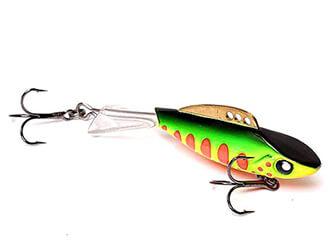
The balancer is designed for catching trophy pike at depth and in difficult conditions. Even a very strong toothed predator will not bite the bait, the body of which is made of a lead alloy, and the tail is made of impact-resistant plastic, resistant to low temperatures.
It is thanks to the long tail that when reeling, the bait quickly turns around and takes a stable position in the water.
The originality of the design of the balancer is the presence of three holes in the upper part, to which the leash is attached. This allows you to change the position of the bait in the water and diversify its animation.
Advantages of Lucky John Pro Series Merabu 67:
- attractive appearance;
- Durable materials are used in manufacturing;
- movable tees on the belly and tail;
- three holes for attaching a leash, helping to diversify the game of the bait;
- more colors for different weather and time of day.
Thanks to the beveled nose, the balancer “dives” in the water when moving, imitating the behavior of a live fish. Lucky John Pro Series Merabu 67 weighs 18 grams, length 67 mm.
Scorana ICE Fox 55
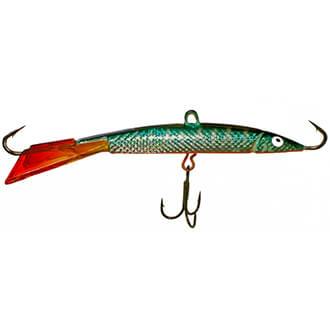
At such times, the pike goes deeper and hunts near holes and cuts, without showing much activity. The Scorana ICE Fox 55 balancer works well both in the current and in the riser, luring fish with its bright colors and interesting “game”. The coating of the bait is an exact imitation of silver fish scales, hooks in the tail and head of an artificial fish, and a tee on the belly.
The weight of the balancer is 10 grams, length is 55 millimeters. Such characteristics make it possible to use the bait when fishing in shallow waters during thaw periods, when the fish rises to the surface, to a source of oxygen. The plastic tail ensures a stable position, and its bright color is attractive to predators.
Advantages of Scorana ICE Fox 55:
- versatility (works both on current and on riser);
- high-quality manufacturing of the case;
- reliable hooks and tee;
- color resembling a living fish.
The versatility and appeal of the Scorana ICE Fox 55 is the reason why every ice fisherman needs one.
What are the best balancers for pike in winter?
Most fishermen prefer products from Scandinavian manufacturers. Their disadvantage is their high cost. Those who consider fishing more utilitarianly choose pike balancers among cheap Chinese products, compensating for the quality of the product itself by improving the technique of wiring and playing with tackle, without losing at all in catchability compared to “branded” models.
In reality, only practice can show which balancer is better for catching pike in winter. As a rule, each fisherman, depending on the fishing conditions and region, has his own working balancers.
In terms of its popularity, fishing for pike with a balance beam in winter has already surpassed fishing with a spoon and has come close to fishing with live bait. But in comparison with the latter, it is considered more sporty and practical, which ensures the growing interest of a large number of anglers in it.
Views: 834
Similar articles:
- Pike fishing in winter Pike fishing in winter is especially interesting. This fish grabs so hard...
- Ice fishing in winter: December, January, February As winter approaches, fishermen begin to actively hunt for predators….
- Catching pike in winter with a spoon. Top 5 best winter lures for pike When cold bodies of water are finally covered with a layer of ice, for many avid…
- Fishing for pike with live bait in winter: which is better? Pike is a dangerous underwater predator that can destroy...
Application of balancers
Fishing for pike in winter using balance beams is usually carried out together with other baits - spoons and ratlins. Fortunately, the fishing rods and tackle for these baits are the same. Winter fishing for pike with a balance beam differs from fishing for perch or pike perch - larger baits are used, and a smoother, more sweeping game is required to attract a toothy fish. The best places for predators to stay are grass and snags. Therefore, you need to understand that baits in such conditions are consumables. In such places, due to the nature of the game, baits are often lost on blind hooks. This can be solved by being careful in exploring new places and using a special cutter. There are no special balancers for pike for winter fishing. Further in the article, specific baits are indicated that, according to anglers’ reviews, work well on the toothy robber.

Do you need a nod on a fishing rod for a balancer?
There is an opinion that a nod is not needed for fishing with balance beams. The fact is that most balancers are quite heavy, they pull the line well, and in this case the nod has absolutely no effect on the performance of the balancer and the sensitivity of the tackle as a whole. If the stretchability of the fishing line is well matched to the weight of the bait, then it is very difficult not to notice the bite, and if we catch what is called a finger, then it is not possible at all.
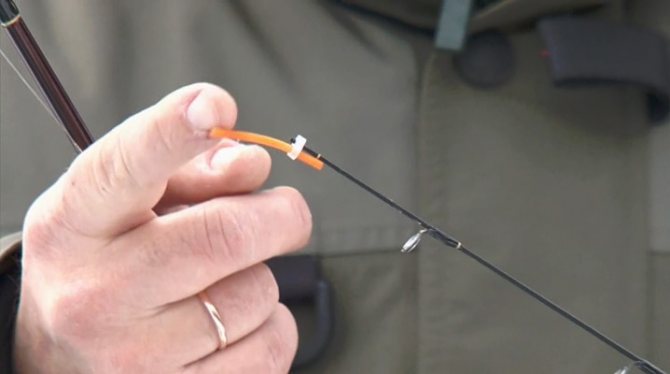
Miniature nod for fishing with small balancers
Using a nod is possible only if we use the smallest balancers 3-4 cm long. It is with such balancers that a miniature nod is often used and allows you to notice careful bites and the passage of fish near the bait. In principle, a nod is needed only when fishing with a spinner, but not in all cases, because a nod revives the play of the spinner, and to revive the play of the balancer, on the contrary, a more rigid connection is needed between the tip of the rod and the bait. In this case, the bait can be controlled more efficiently.

